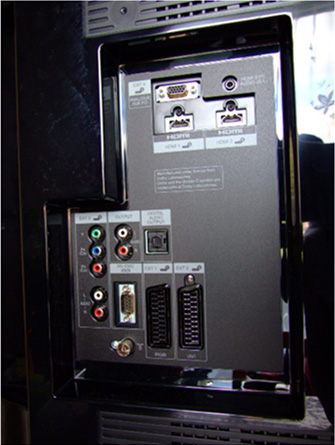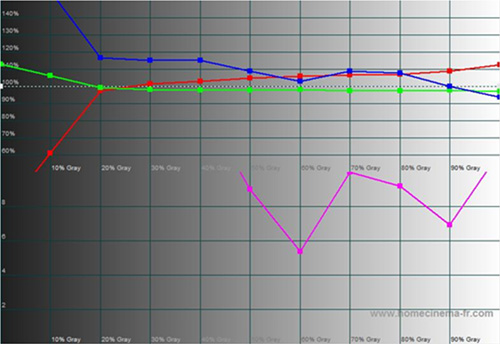Not so long ago, Sharp LCD HDTVs were the golden jewels of home electronics. Their quality was simply unbeatable and oozed opulence from every angle. Simply put, Sharp flat panel TVs were the Kuro of their days. But that all changed in 2007 when Sharp adopted a newer-simpler design (for the Western market). In truth, Sharp no longer invest heavily in the European and the U.S market due to the heavy competition from budget and Korean brands such as Samsung, LG and Vizio. So if you’re after a high-quality Sharp flat screen television model, you’ll have to import one directly from Japan.
<!-- google_ad_client = 'pub-2887677957235196'; google_ad_slot = '4990177225'; google_ad_width = 336; google_ad_height = 280; //-->
Before I move on, I must point out that the Sharp LC42DH77E (also marketed as the Sharp LC42DH77) is very similar to its predecessor the Aquos LC42B20E which was reviewed in July last year.

The overall design of the Sharp LC42DH77E is very similar to the Aquos B20 series with minor modifications, which some find rather attractive. The build quality appears solid and so are the connection ports.
The Sharp LC42DH77E HDTV features three HDMI inputs (two at the rear and one on the side), and also VGA, two SCARTs (but only one is RGB enabled), component, composite, PCMCIA type II, USB, optical out, headphone out and analogue audio out.
 | |
| Rear connections |
The OSD on the Sharp LC42DH77E hasn’t changed much from the previous model. However, they have added hue and saturation controls for primary and secondary colours, which are somewhat useless without the ability to control RGB/white levels. The responsiveness in my opinion is acceptable, though switching between inputs can be slightly aggravating. However, the simplicity does favour the average user.

Again, nothing has changed here. The remote is pretty average and the layout could be improved to allow better interaction. For example, the input select, DTV, ATV, Radio and EPG should be placed at the top instead of the seriously outdated teletext buttons.
As with most mid-range sets, the Sharp LC42DH77E LCD television also lacks user configurable greyscale control via the main-menu. Unfortunately for the Sharp LC42DH77E, that’s where the problem begins as the preset greyscale is quite poor compared to today’s standards. However, it may be possible to rectify this issue via the service menu (which may void your warranty and therefore is not recommended).
 |
| “Warm 2” CCT |
As you can see from the image above, the colour temperature varies greatly and it does impact the image quality to an extent.
 |
| “Warm 2” RGB tracking |
As you can see from the RGB chart, the blue and red are somewhat over dominant, but the green remains fairly stable after 20% stimulus.
 |
| “Warm 2” gamma tracking |
Despite my attempts to obtain stable gamma value, I was unable to get close to the desired value of 2.2.
 |
| “Warm 2” CIE chart with reference to HD Rec. 709 specifications |
There’s no surprise here and the graph pretty much speaks for itself.

| Default [Dynamic] mode | ~234 watts |
| Calibrated [Movie] mode | ~100 watts |
| Standby | <1 watt |
Sharp still hasn’t fixed the vertical banding of the panel, which plagued the Aquos range since 2006. The effect can be seen without applying too much of an effort, especially during games (at least in my case). Whether or not this is a problem depends on the individual’s perception as some may fail to notice the effect.
The black uniformity was excellent as I did not detect any uneven backlighting. The blacks (greys) appeared smooth corner to corner. However, the white uniformity was slightly unforgiving as certain parts of the screen were contaminated with minor tinting, which wasn’t noticeable under normal viewing conditions and contents.
I was somewhat impressed by the Sharp LC42DH77E’s black level performance but wasn’t astonished. After calibration, it did manage to produce ANSI contrast ratio of ~1600:1, which isn’t too bad.
Like its predecessors, the Sharp LC42DH77E was bundled with features such as OPC (automatic/adaptive-backlight-dimming) and adaptive contrast correction (Active Contrast), which may be of use to some, but they are better left disabled. However, the Active Contrast feature does help to improve the SD contents via analogue inputs.
Sharp’s implementation of MCFI is rather average to be honest and the improvement in motion was only visible with high-tone contents. Contents composed of low-tone colours suffered from visible smearing, which was perceivable when playing 60p games. In fact, when playing HALO 2 via my PC, I could perceive more detail on my 2209WA than on the Sharp LC42DH77E with MCFI enabled (in most areas). I suspect the cause of this problem is down to the way the panel is driven and the incorrect use of over-drive. This has, continues to be an issue with some panels based on Vertical Alignment technology.
However, for sports and average soaps, it shouldn’t be a problem due to the method of perception (tracking vs. none-tracking) and the quality of content. For example, during gaming, the user continuously tracks the screen and since the content is graphics based, it’s easier to detect screen and image defects/artifacts. However, when viewing soaps or news, the user simply absorb the image where most artefacts remain passive.
On a brighter note: Sharp did not unify high-level and low-level MCFI. So enabling 100/120Hz will not induce soap effects in movies and seasonal programs. But if you’re fan of the low-level MCFI, enable film mode and select Advanced.
In order to maximize the performance of the built-in speakers, the set needs to be placed on a traditional TV stand for the sound to be deflected; otherwise it can appear rather hollow. As with most flat panels, the bass from the Sharp LC42DH77E speakers sounded damped, but the mids and the highs seems to be acceptable. In my opinion, it’s better to invest in a sound system or purchase a pair of stylish active speakers (with a remote).
Out of the box, an experienced user could easily spot the inaccuracies in the image quality. However, with the Sharp LC42DH77E, this is true even after post-calibration via the user menu. Displaying samples which I’ve carefully composed over the months highlighted the imperfections in colour and gamma.

Skin tones are one of the most important aspects of image quality. Unfortunately, the Sharp LC42DH77E failed to render it correctly. The image had blue dominance and the tone of the skin appeared rather pale. There was very little detail/substance to the image in my opinion. For example, I was unable to distinguish the variant shades of colours of Charlize Theron’s face, neck and chest. The difference was far more noticeable once I’ve directly compared the image to the Dell and the BRAVIA.

This image will highlight any inaccuracies in colour, greyscale and gamma. As with the previous image, blue dominance was evident, yet the greys (snow on the platform) appeared warmer then 6500K, which was in accordance with the CCT chart. The image lacked depth and black crush was evident on the bogie, under the bridge and near the front of the train. In addition, the silver-grey hull appeared to have mild red dominance. Overall, the image was far from accurate.

On this image, the Sharp failed to produce the correct shade of green and yellow. Black crush was also evident in this image (shelters) and the over-all quality image appeared artificial to say the least. No amount of tinkering could fix the high level of gamma or the colour inaccuracy.
Overscanning: The Sharp LC42DH77E LCD HDTV allows the user to enable Dot to Dot (1:1 Pixel Mapping) when using HDMI at 1080p, and yes, it does significantly improve the static image quality. However, due to the triangular architecture of the sub-pixels, fine details appeared pixelated and lacked definition. Therefore, I cannot wholeheartedly recommend the Sharp LC42DH77E for PC usage.
| Subpixel architecture of Sharp LC42DH77E |
Blacker than Black (HDMI): The Sharp LC42DH77E does accept both VESA and CEA signals. So it’s compatible with Computer and Consumer Electronics Standards. In English, it can accept and display 0-255 and 16-235 levels automatically.
Preferred Colour Space (HDMI): Unfortunately the Sharp LC42DH77E doesn’t like YCbCr via HDMI as it produced highly visible image artifacts (almost similar to a horizontal banding). Using RGB Colour Space fixed this problem.
Greyscale Banding: It wasn’t highly visible and was more than acceptable in my opinion.
Sharpness: Thankfully, the Sharp LC42DH77E doesn’t suffer from any form of artefacts caused by edge enhancements. The level of EE can be fully controlled via the user menu.
Colour Banding and Posterization: Somehow I don’t think the Sharp LC42DH77E utilises a 10bit video processor. Vertical colour banding and posterization were visible when I viewed high quality contents on-screen. It didn’t bother me too much, but couldn’t help noticing at times.
Viewing Angles: The viewing angles of Sharp’s ASV LCD panel continues to remain very average and just because it’s a variant of VA doesn’t excuse it to be, especially when the latest VA panels from AUO and Samsung have significantly better viewing angles.
The Sharp really does shine with HD contents (like all HDTVs) and it accepts and processes 24p perfectly. The motion of 24p contents did appear smooth and sturdy, which is a big plus. However, the inaccurate colours did act as a distraction.
Unfortunately, I was unable to test DVB-T due to the lack of good/quality signal. However, the image quality via RGB was very good. Visible noise was minimal and smearing was virtually nonexistent. However, during dark scenes, the image did appeared muddy; but enabling Active Contrast helped to resolve this issue without degrading the image too much.
Scaling: Sharp’s scaling algorithm is average compared to today’s standards. Subtle details were lost during up-sampling of 576i contents via component video and RGB SCART.
Video-mode Deinterlacing: Sharp failed in this category as well. On a smaller set, this would’ve been forgivable, but on a 42-inch, absolutely not.
Film-mode Deinterlacing: Sharp also failed in this category, which is somewhat of a surprise as the previous model didn’t.
Digital Noise Reduction: Sharp’s implementation of DNR was good. It suppressed compressions and other forms of noise without inducing highly visible smearing effect.
Thankfully, all four video processing can be outsourced to an external device for critical viewing. For those with standard Sky STB and Sky+, it’s not a problem and the DNR should help with compression artefacts.
All in all, there’s nothing special about the Sharp LC42DH77E LCD TV. However, if Sharp were to aggressively price the Sharp LC42DH77E, it may become popular among the budget-conscious.
<!-- google_ad_client = 'pub-2887677957235196'; google_ad_slot = '0693194791'; google_ad_width = 336; google_ad_height = 280; //-->